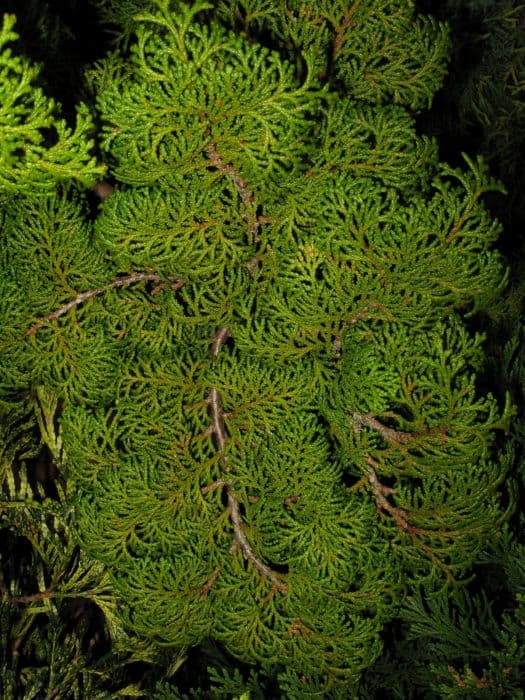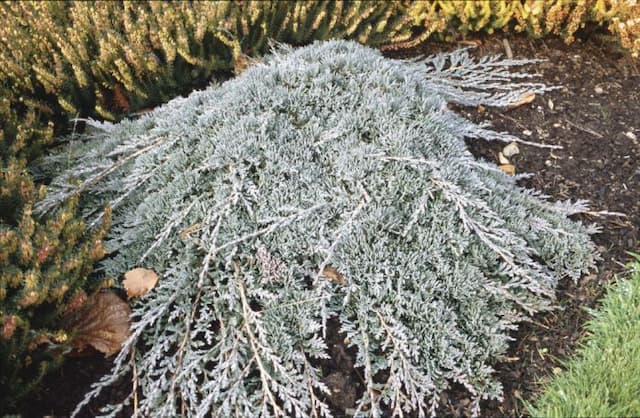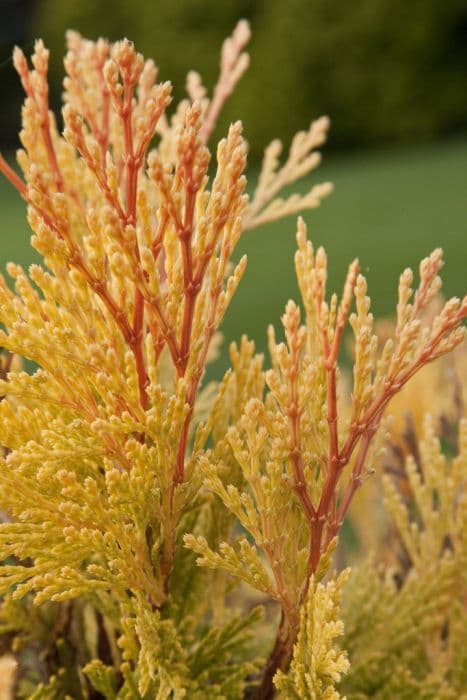Skyrocket Juniper Juniperus scopulorum 'Skyrocket'











ABOUT
The 'Skyrocket' Juniper, often known for its remarkably narrow and columnar shape, presents itself as a strikingly vertical accent in the landscape. Its densely packed branches grow upward in a tight fashion, resembling a tall, slender pyramid or rocket, a silhouette that truly sets it apart from other conifers. The foliage maintains a rich, bluish-green hue throughout the year, offering a vibrant splash of color even during the colder months when other plants may lose their luster. The leaves of 'Skyrocket' are small, scale-like, and tightly appressed to the branches, which gives the tree a somewhat textured appearance up close. Although the individual leaves are hardly noticeable on their own, collectively they create a dense and feathery surface that is soft to the touch. When examined, the foliage may release a characteristic resinous scent that is often associated with juniper varieties, adding sensory appeal to its visual characteristics. While it's typical for 'Skyrocket' Junipers to produce small, berry-like cones, these may not always be prominent or noticeable without closer inspection. These cones can start off as a bluish color, blending with the foliage, before eventually maturing to a more brownish hue. The bark on 'Skyrocket' is fibrous and may exhibit a reddish-brown color, offering a textured look and feel to the sturdy trunk and branches that support the dense growth of the striking foliage.
About this plant
 Names
NamesFamily
Cupressaceae.
Synonyms
Skyrocket Juniper, Rocky Mountain Juniper, Columnar Juniper.
Common names
Juniperus virginiana var. scopulorum, Sabina scopulorum, Juniperus virginiana f. scopulorum.
 Toxicity
ToxicityTo humans
The Skyrocket Juniper is not considered highly toxic to humans. However, consuming parts of the plant, particularly the berries, might cause mild gastrointestinal upset if ingested in large quantities. Symptoms of ingesting the plant include nausea, vomiting, and diarrhea. These symptoms are typically not severe, but it's advisable to seek medical attention if significant consumption occurs or if symptoms persist.
To pets
The Skyrocket Juniper is generally not toxic to pets. Ingesting small amounts may result in mild stomach upset in some animals, similar to humans. Symptoms could include vomiting or diarrhea, which should be monitored. If a pet ingests a large quantity of the Skyrocket Juniper or if symptoms are severe or persist, it is recommended to consult a veterinarian.
 Characteristics
CharacteristicsLife cycle
Perennials
Foliage type
Evergreen
Color of leaves
Blue-green
Height
15-20 feet (4.6-6 meters)
Spread
2-3 feet (0.6-0.9 meters)
Plant type
Shrub
Hardiness zones
4-7
Native area
North America
Benefits
 General Benefits
General Benefits- Drought Tolerance: Once established, juniper Skyrocket requires little water, making it suitable for xeriscaping and drought-prone areas.
- Low Maintenance: It does not require frequent pruning or deadheading, and is generally free from major pest and disease problems.
- Wildlife Habitat: Provides shelter for birds and other wildlife within its dense foliage.
- Privacy Screen: With its columnar form, it is ideal for creating privacy screens or hedges without taking up much horizontal space.
- Soil Stabilization: The extensive root system can help prevent soil erosion on slopes and embankments.
- Architectural Interest: Adds vertical interest to landscapes with its narrow, upright growth habit and blue-green foliage.
- Year-Round Interest: Being evergreen, it maintains its color and form throughout all seasons, providing consistent landscape appeal.
- Deer Resistance: It is resistant to deer browsing, which makes it suitable for areas where deer are a common problem.
 Medical Properties
Medical Properties- Antiseptic: The essential oil of Juniperus scopulorum 'Skyrocket' possesses antiseptic properties.
- Antirheumatic: Traditional uses have included treating rheumatic pain, although not scientifically substantiated.
- Diuretic: It has been used to promote urine production to support kidney function, but clinical evidence is lacking.
 Air-purifying Qualities
Air-purifying QualitiesThis plant is not specifically known for air purifying qualities.
 Other Uses
Other Uses- Insect Repellent: The aromatic oils in Skyrocket juniper can deter insects, making it useful around patios or windows.
- Wildlife Shelter: Dense foliage offers protection and nesting opportunities for birds and small animals.
- Erosion Control: The plant's robust root system helps stabilize slopes and prevent soil erosion.
- Windbreak: These tall, columnar trees can be planted in rows to create a natural wind-blocking barrier.
- Privacy Screens: Planted closely together, they create a living privacy screen without taking too much horizontal space.
- Topiary: With careful pruning, Skyrocket juniper can be shaped into ornamental topiaries for garden display.
- Soil Improvement: Falling needles from the juniper decompose and add organic matter to the soil, which can improve soil quality over time.
- Theme Gardens: 'Skyrocket' can be included in a conifer or evergreen theme garden due to its striking form and year-round interest.
- Holiday Decor: Branches from the Skyrocket juniper can be used in wreaths, garlands, or other holiday decorations.
- Photography: The unique shape and texture of the plant make it an interesting object for plant photography and garden portfolios.
Interesting Facts
 Feng Shui
Feng ShuiThe Skyrocket Juniper, due to its upright and narrow growth habit, can be used in Feng Shui to create a sense of upward movement and growth, potentially inviting positive energy, or chi, into a space. It might also be placed in the East sector of a garden to promote health and family harmony or in the Southeast to attract wealth and abundance, as wood is the element associated with these areas.
 Zodiac Sign Compitability
Zodiac Sign CompitabilityThe Skyrocket Juniper is not used in astrology practice.
 Plant Symbolism
Plant Symbolism- Protection: Junipers have been used throughout history in various cultures for their protective properties, with many traditions using them to ward off evil spirits and negative energies. The 'Skyrocket' juniper's tall, upright form may symbolize a strong barrier or shield.
- Cleansing: With its fresh, invigorating scent, the juniper plant is often associated with purification. In some cultures, juniper branches are burned to clear the air and cleanse spaces of impurities.
- Healing: Juniper is known for its medicinal properties, including its use in treating various ailments. The 'Skyrocket' juniper's robust growth might symbolize health and vitality.
- Longevity: Juniper trees are renowned for their long lifespan and hardiness. The 'Skyrocket' variety's endurance in a range of climates and conditions speaks to the symbolic meaning of longevity and perseverance.
- Rebirth: Some cultures link junipers with renewal and rebirth due to their evergreen nature and ability to thrive in challenging environments, signifying resilience and new beginnings.
 Water
WaterThe Skyrocket Juniper, prefers dry to medium moisture levels and does not require frequent watering once established. In the first growing season, it is essential to water it regularly to help establish a strong root system. Water the plant deeply once a week, providing about 1 to 1.5 gallons each time, depending on soil conditions and climate. After establishment, decrease the frequency, allowing the soil to dry out between waterings. Over-watering can lead to root rot, so it's crucial to ensure good drainage and to adjust the watering schedule during rainy periods to avoid excess moisture.
 Light
LightThe Skyrocket Juniper thrives best in full sun conditions, which means it needs at least 6 hours of direct sunlight daily. Place it in a location where it can receive unfiltered sunlight throughout the day for optimal growth and health. Although it can tolerate some light shade, too little light can lead to sparse foliage and a less robust form.
 Temperature
TemperatureThe Skyrocket Juniper is hardy and can withstand a wide range of temperatures, preferring climates with temperatures that typically range from -30 to 100 degrees Fahrenheit. Though it is resilient, extreme and prolonged temperatures beyond this range can stress the plant. The ideal temperature for this juniper is between 40 to 70 degrees Fahrenheit for vigorous growth.
 Pruning
PruningPrune the Skyrocket Juniper to maintain its narrow, columnar shape or to remove any damaged or diseased branches. Pruning is typically not required frequently, but if necessary, the best time to prune is in late winter or early spring before new growth starts. Avoid heavy pruning as Junipers do not respond well to cutting into old wood.
 Cleaning
CleaningNot needed
 Soil
SoilThe best soil mix for Rocky Mountain Juniper 'Skyrocket' is a well-draining mix with components like sand, gravel, and compost to emulate its native habitat. A slightly acidic to neutral pH between 6.0 and 7.5 is ideal to support healthy growth.
 Repotting
RepottingRocky Mountain Juniper 'Skyrocket' generally needs repotting every three to four years, but as a slow grower, it may not require frequent repotting if planted in the ground.
 Humidity & Misting
Humidity & MistingRocky Mountain Juniper 'Skyrocket' tolerates a wide range of humidity levels and does well in outdoor environments where humidity is not artificially controlled.
 Suitable locations
Suitable locationsIndoor
Provide bright light and good air circulation for 'Skyrocket'.
Outdoor
Choose a sunny spot with well-drained soil for 'Skyrocket'.
Hardiness zone
4-7 USDA
 Life cycle
Life cycleThe life cycle of 'Skyrocket' Juniper (Juniperus scopulorum 'Skyrocket') begins with seed germination, which is typically slow and can be improved with stratification. Seedlings initially establish a taproot and grow slowly, developing needle-like juvenile leaves. As the plant matures, it transitions to adult foliage with scale-like leaves and begins vertical growth, characteristic of its columnar habit. Sexual maturity is reached within a few years, at which point it may produce cones—female plants produce blue, berry-like cones (juniper 'berries') while males produce smaller, brown cones that release pollen. Under optimal conditions, 'Skyrocket' Juniper can live for several decades, continuing to grow taller and producing cones annually. Over time, the plant may become woodier at the base with a thickened trunk and can eventually succumb to old age or environmental stresses.
 Propogation
PropogationPropogation time
Spring-Early Summer
Juniperus scopulorum 'Skyrocket', commonly known as Skyrocket Juniper, is best propagated through semi-hardwood cuttings. This method, usually performed in late summer to fall, involves taking 4 to 6 inch (10 to 15 cm) cuttings from the current year's growth that has started to mature but is not yet fully hardened. Before planting, the cut base of the cutting should be dipped in a rooting hormone powder to encourage root development. The cutting is then placed in a well-draining rooting medium, such as a mix of peat and perlite, ensuring high humidity and consistent moisture without waterlogging. Cuttings need to be placed in indirect light and can take several weeks to root successfully, after which they can be transplanted into individual pots or their final location.









